Vertical Gardening: How to Grow More in Less Space
Use vertical options to maximize your garden space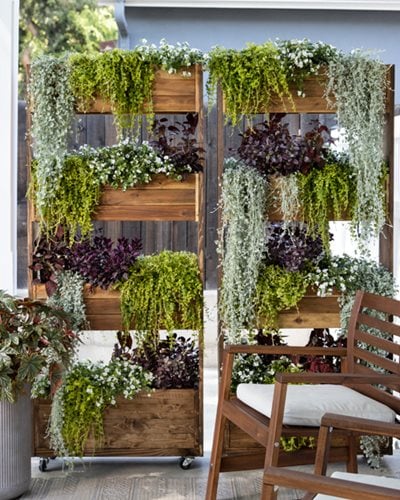
See how to build these privacy wall planters in Vertical Garden DIY Projects below. Photo: Proven Winners.
With lot sizes shrinking and more people living in condos and apartments, every inch of space is at a premium. Vertical gardening is a way to maximize a small garden space or underused feature such as a wall, fence, or other gardening structure.
To utilize vertical outdoor space, plants can be grown up a trellis, arbor, or other structure, or allowed to trail out of a hanging basket or planter box. Displaying containers or pocket pouches on a fence or wall is another way to get more out of your growing space. Here are some basics considerations for vertical gardening, along with ideas for inspiration.
Featured in: Garden Design's Top 9 Garden Trends for 2023 ("Going Vertical")
On this page:- TYPES OF VERTICAL GARDENS OR SUPPORTS
- VERTICAL GARDEN CONSIDERATIONS
- FREQUENTLY ASKED QUESITONS
- VERTICAL GARDEN IDEAS & INSPIRATION
- VERTICAL GARDEN DIY PROJECTS
TYPES OF VERTICAL GARDENS OR SUPPORTS
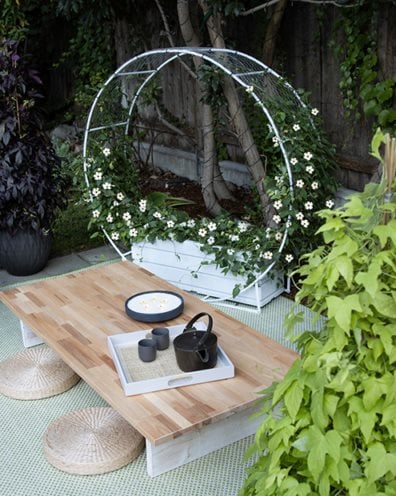
See how this arch trellis was created. Photo: Proven Winners.
A vertical garden can be used to create privacy, establish boundaries, block out an unsightly view, or to cover an ugly wall or fence. Here are some of the most common types of vertical gardens or supports.
Arbor, trellis, or pergola: Use one or more of these structures to train perennial climbing roses, wisteria, clematis, or honeysuckle. Fast growing annual vines can be used as a quick screen. (See: 21 Best Flowering Vines)
Hanging baskets, planter boxes, and containers: Plants can be grown in hanging planters or baskets on a porch, patio, deck, or shepherd’s hook. Display planter boxes on a home, garden shed, or fence. Pots can be affixed to a fence, displayed on a shelf, or suspended in plant hangers. See more on container trellising.
Fence: Attach shelving, pouches, or other containers to a fence to grow small perennials, annuals, herbs, strawberries, and other edibles.
Wall: Any type of wall can be used to train vining plants. Some plants such as ivy can attach themselves to walls with aerial roots. Trees and shrubs can be espaliered, while other plants will need a trellis for support.
Living walls: More typically used in public or corporate settings, a permanent wall garden can also be used in a residential landscape. These vertical structures utilize a growth medium of soil, substrate, or hydroponics, and usually include built-in irrigation systems. Climbing or cascading plants are trained to cover the wall space for a lush display of vegetation.
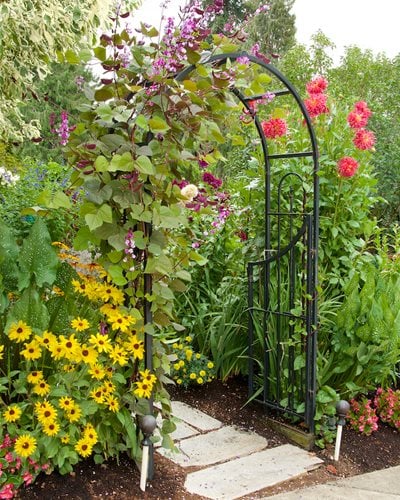
Fast growing annual vines provide quick cover and screening. Hyacinth bean (Lablab purpureus), which produces colorful pea-like blooms, covers this metal arbor leading into the garden. Elaine Nelson garden. Photo by: Janet Loughrey.
VERTICAL GARDEN CONSIDERATIONS
Here are some things to keep in mind when designing and building a vertical garden.
Make it secure: Insure that walls, fencing, vertical planters, or other structures are sturdy enough to support the weight of containers and plants. Affix planting containers securely so they don’t become detached or fall.
Provide adequate support: Larger perennial vines such as wisteria and trumpet vine need a sturdy arbor or pergola to support the weight and vigorous growth. Smaller vines such as most clematis or annuals can be grown on smaller trellises.
Soil: Provide the right growing conditions for plants such as climbing roses or wisteria vine that are planted in the ground. For containers, use a high quality all-purpose potting soil. Some living wall systems are hydroponic, using no soil.
Water: Plants in the ground can be watered according to individual needs. Make sure containers have adequate drainage holes to prevent root rot. Potted plants dry out more quickly and will need more frequent watering or misting.
Fertilizer: Containers or pouches leach out nutrients more quickly due to frequent watering. Add a slow-release fertilizer at the time of planting and supplement with water-soluble fertilizer throughout the growing season.
Fertilizing needs vary according to the type of plant. Sedums, succulents, and ornamental grasses will need less fertilizer, while most warm-season annuals and edibles need more. For plants in the ground, fertilize according to individual requirements.
Pruning and maintenance: Perennial vines such as wisteria and trumpet vine need proper and regular pruning. Make sure this is something you have the time and expertise to do.
FREQUENTLY ASKED QUESTIONS
What plants grow well in vertical gardens?
Nearly any trailing or climbing plant can be grown vertically as long as they are given the right growing conditions and proper support. Plants to grow include perennial or annual vines, small perennials, sedums and succulents, ornamental grasses, ferns, annual flowers, edibles, and houseplants.
What are the benefits of vertical gardening?
Vertical growing can maximize the use of a small space, create lush privacy screening and help to keep an area cool, such as underneath a pergola. Some plants perform better when trained vertically.
Can you grow vegetables in a vertical garden?
Many vegetables including vining tomatoes, cucumbers, and squash can thrive in a vertical garden or hanging basket. Create a vertical herb garden or grow strawberries and lettuce in a wall planter.
VERTICAL GARDEN IDEAS & INSPIRATION

A cordon espalier consisting of multiple trees screens an intimate patio. Espaliered trees or shrubs can be used in front of a fence or wall, as a free-standing hedge to divide garden rooms, or to define a property line. Read more: Using Espaliers in the Garden.

A living wall was bolted onto an existing retaining wall and planted with succulents and perennials in different foliage colors and shapes, livening up this functional outdoor space. Photo by: Karl Seifert.

Slatted wooden panels and living walls turn an open balcony into a shady retreat. Planter boxes and macrame hangers brimming with ferns and other shade lovers provide additional vertical interest. Photo by: Tapui / Shutterstock.
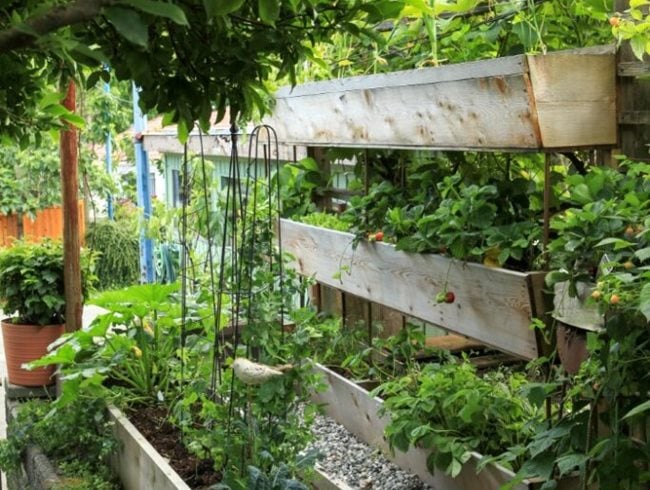
Stephanie Rose, of Garden Therapy blog and website, calls her 3-tier raised garden bed a "unique solution that was born out of necessity." Not only did this solution provide her with an extra 40 square feet of garden space, but its layers also gave her sun and shade options for planting. See more on how & why she built this creative vertical garden. Photo by: Stephanie Rose, Garden Therapy

Use vertical plantings to keep outdoor living spaces cooler in summer. This secluded seating area is thickly covered with lush vines, offering shade and privacy. Photo by: Proven Winners.

A tall wooden fence is softened with vines and shrubs. Window boxes planted with petunias and other warm season annuals provide additional vertical interest and a bright pop of color all summer long. Photo by: Proven Winners.

A vertical pocket planter in this small courtyard includes an eclectic mix of succulents, perennials, ferns, and ornamental grasses. Designer: Philip Thornburg, Winterbloom Landscaping. Photo by: Janet Loughrey.
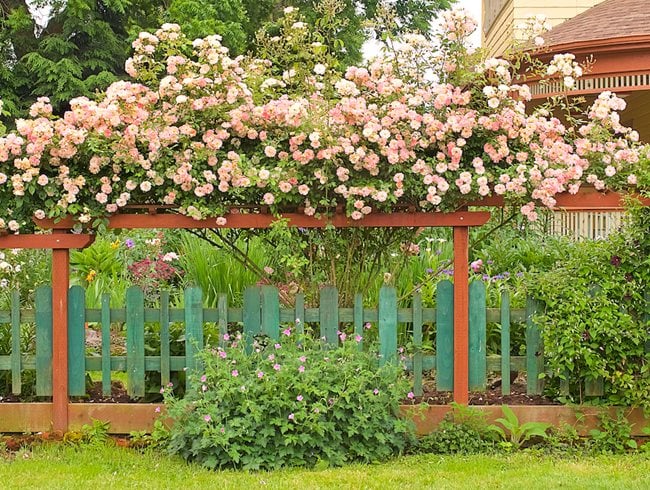
A climbing heirloom rose was trained along the top of this open fence for a spectacular floral display. Roses need regular training and adequate support for a successful vertical display. Designers: Wayne Hughes and Danny Hills, Lonesomeville Gardens. Photo by: Janet Loughrey.

Recycle an old stepladder as an innovative and budget-friendly vertical gardening option. Mindy Northrop garden. Photo by: Janet Loughrey.
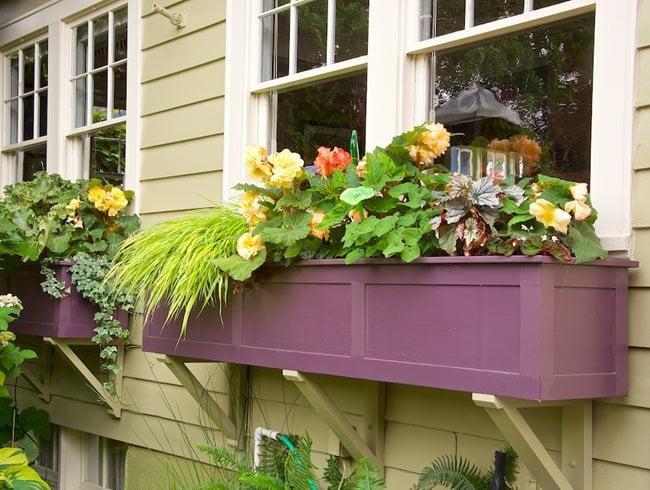
Brightly painted window boxes light up this semi-shaded front yard. Colorful begonias, ivy, and Japanese forest grass comprise these shade-tolerant plantings. Dennis and Connie Schweppe garden. Photo by: Janet Loughrey.

Decorative ceramic pots are displayed on a fence crossbeam that became a makeshift shelf. Dennis and Connie Schweppe garden. Photo by: Janet Loughrey.

Whimsical octopus planters adorn the wall of this small courtyard. A tall pot planted with a columnar conifer provides additional vertical interest. Designer: JJ DeSousa. Photo by: Janet Loughrey.
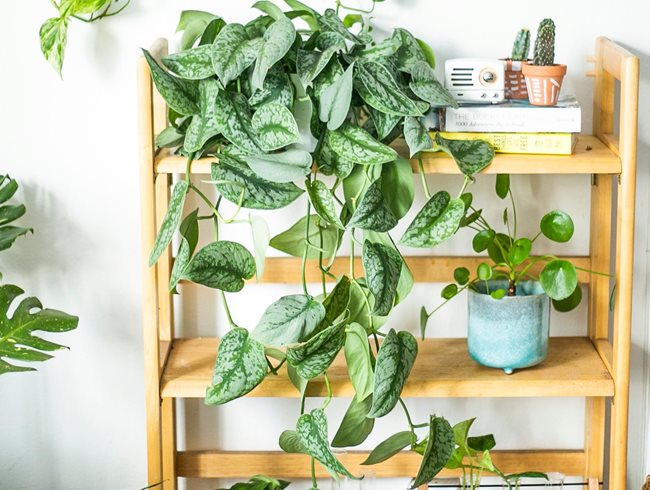
Adorn indoor spaces with trailing houseplants displayed on a shelf, rack, stool or in a hanger. For plants such as monstera or pothos, train plants up a moss pole or trellis. Photo by: Tammy Nguyen.
VERTICAL GARDEN DIY PROJECTS
Create your own vertical garden with these DIY projects. Use trailing or climbing plants with different sizes, foliage, and flowers for months of continuous color.
Privacy Wall Planter
 Build This!
Build This!
Create privacy on a patio, deck, or apartment balcony with stacked planter boxes. Add quick-growing annual vines and other trailing plants such as Supertunia® petunias or Superbells® for a lush color display.
Thunbergia Wall
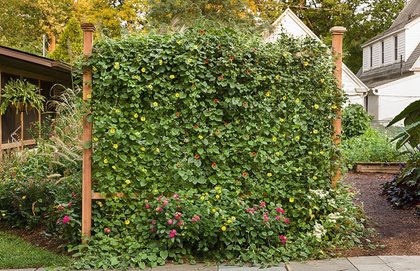 Grow This!
Grow This!
Build a free-standing trellis wall using thunbergia as a living screen. This quick-growing, warm-season annual thrives in full sun and can cover a large trellis wiht daisy-like flowers in just two months.
Terra Cotta Planter Wall
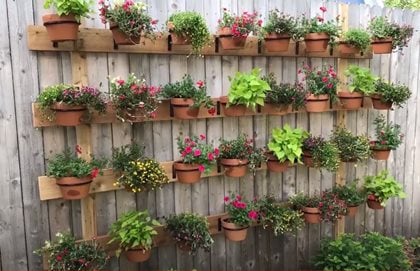 Build This!
Build This!
Use a wooden fence as support to build this vertical garden featuring small clay pots suspended on wrought iron planter rings. Add a WaterWise® drip irrigation system to make watering chores a snap.
